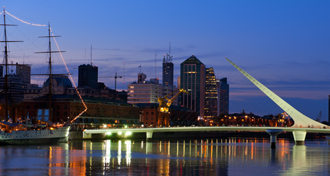
Not unlike its vast interior, Argentina’s capital is a sprawling mosaic. On day one of a visit, a driving tour will help to distinguish its characteristic barrios, highlighting colorful La Boca, nostalgic San Telmo (whose Sunday flea market brings a weekly flurry of antiques and souvenirs to picturesque cobblestone squares), and the glossy new Puerto Madero waterfront, its sleek statement culminating in Santiago Calatrava’s Bridge of the Woman.
Patrician Recoleta and trendy Palermo deserve to be explored on foot. After winding through the Recoleta Cemetery, enjoy a good walk across the Avenidas del Libertador and Figueroa Alcorta, stopping to admire the Floralis Genérica, the monument given to the city by architect Eduardo Catalano in 2002. (Its massive steel petals open every morning at dawn and close again at sunset.) Continue northeast through leafy Palermo Chico to glimpse some of the city’s loveliest mansions; though many have now been converted into foreign embassies, at the turn of the 20th century they were home to Argentine society’s most prominent families. Doma, at the epicenter of Palermo Soho, is filled with shops showing a rainbow of beautifully constructed leather jackets and Humawaca creates unique handbags and briefcases that make wonderful gifts.
If Buenos Aires' ubiquitous heladerías (ice cream parlors) are any indication, ice cream figures as prominently in porteño gastronomy as steak. Any long walk through the city is an excuse to treat oneself to an helado, and given the frequency with which Volta, Freddo, and Persicco present themselves, resisting is nearly impossible. The essential flavor to sample - in all its many variations - is of course, dulce de leche.
Contemporary art aficionados should plan to visit both the MALBA (Buenos Aires Museum of Latin American Art) and the Colección Amalia Fortabat. The latter houses the private collection of an Argentine cement heiress, juxtaposing works by Turner, Klimt, Rodin, an assortment of Argentine masters, and family portraits by Andy Warhol and Antonio Berní.
Opera buffs should attend a performance at the legendary Teatro Colón, whose acoustics are considered to be among the best in the world. The Faena Hotel Buenos Aires is home to Rojo Tango, the most polished and professional of the city’s innumerable tango shows; it books up quickly, so tickets should be purchased well in advance. After admiring the dancers’ moves and taking a lesson or getting some practice at a local milonga, women will want to don the appropriate footwear; exquisite tango-worthy stilettos can be custom ordered at Recoleta-based outfitter Comme Il Faut.
Visitors eager to cover a little extra ground can take a ferry to visit the historic town of Colonia del Sacramento, which lies directly across the Río de la Plata in Uruguay, or spend a few hours learning to play polo at an estancia outside of the city. Of course, anyone favoring a more leisurely afternoon of pastries and idle conversation will be in excellent company in Buenos Aires; afternoon tea is a longstanding Recoleta tradition and a welcome antidote to the standard 10:30 pm dinner reservation.
Though the steaks they serve may appear to be identical, Argentine parrillas tend to have very different personalities. Cabaña Las Lilas is a corporate classic, ideal for an al fresco power lunch (in Buenos Aires, even executives make time for lavish midday meals), while the youthful and vibrant Miranda is perfect for a Friday night. Few parties have influenced the city's culture so profoundly as its Italian immigrant population, so when you've tried every imaginable cut of meat, you'll do well to substitute homemade pasta from Sottovoce. Post-dinner migrations lead to Milión or Thames 878 for artisanal cocktails around midnight, but visitors won’t even begin to feel Argentine until they have seen the sunrise on their walk home.
